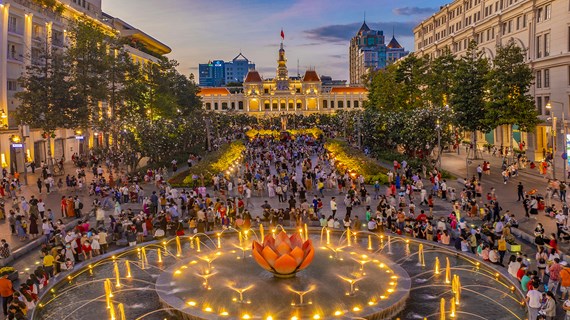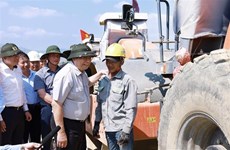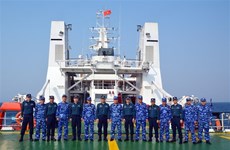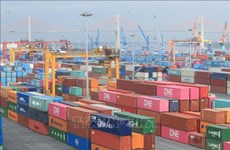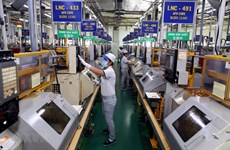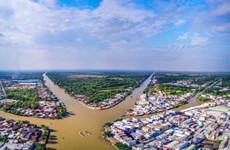GMS transport projects make Vietnam better connected
Hanoi (VNA) – Vietnam has got
better connected with other countries in the Greater Mekong Sub-region (GMS)
thanks to a wide range of projects on transport infrastructure development
conducted within this cooperation framework.
Vietnam is the only country in the
GMS that has participated in all three economic corridors. They include the north-south
corridor that connects Vietnam with China, the east-west to link Thua Thien-Hue
province and Da Nang city in the central region with Laos and all the way to
Thailand and Myanmar and finally the southern one bridging HCM City with Phnom
Penh and Bangkok.
According to Vietnamese Deputy
Minister of Transport Le Dinh Tho, with financial aid from sponsors, especially
the Asian Development Bank (ADB), and concerted efforts, Vietnam has been
completing works within these important connectivity corridors. Connecting with
China, Vietnam put the Kunming – Lao Cai – Hanoi – Hai Phong expressway into
use in December 2015.
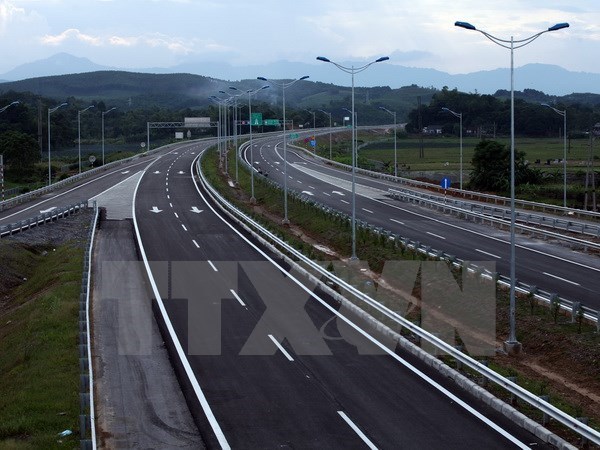 Hanoi - Lao Cai expressway, the longest of its kind in Vietnam, was put into operation in September 2014 as part of the North – South Economic Corridor (NSEC)(Photo: VNA)
Hanoi - Lao Cai expressway, the longest of its kind in Vietnam, was put into operation in September 2014 as part of the North – South Economic Corridor (NSEC)(Photo: VNA)
Notably, the Hanoi – Lao Cai expressway with a total length of 264 km and investment
of 1.2 billion USD sourced from the ADB was considered a strategic part of the
Kunming – Lao Cai – Hanoi – Hai Phong road corridor under the cooperation
programme between the six GMS countries, namely Vietnam, Laos, Cambodia,
Thailand, Myanmar and China.
The expressway, the longest of its
kind in Vietnam, was put into operation in September 2014 as part of the North
– South Economic Corridor (NSEC), helping reduce travel time between Hanoi and
the northern border province of Lao Cai from seven to three hours and
facilitating the transport of goods.
It is not only important to Vietnam
but also the whole GMS region by changing the economic panorama of localities in
northern Vietnam and southern China through enhancing transport connectivity,
trade exchanges, investment and tourism cooperation.
The Nanning – Lang Son – Hanoi – Hai
Phong and Hai Phong – Ha Long – Van Don – Mong Cai – Pingxiang expressways are
set to become operational before 2020.
The East-West Economic Corridor
(EWEC) features Da Nang Port – Dong Ha (along National Road No.1) – Lao Bao
International Border Gate – National Road No. 9 of Laos – Thailand – Dawai Port
of Myanmar route with a total length of 1,450 km. This is an important corridor
that helps shorten road travel time from the Pacific Ocean to the Indian Ocean
to three hours.
Another route in the east-west corridor running along National Road 217, funded
by the ADB, will be completed soon.
On the basis of the east-west corridor linking the Pacific Ocean and the Indian
Ocean, Vietnam and Laos have put forth an initiative to build another corridor
from Myanmar to Laos via Thailand, running along Paksan (Laos) – Thanh Thuy International
Border Gate – Vinh (Vietnam’s Nghe An province) section to Vung Ang Port in the
central province of Ha Tinh. It is a branch of the Hanoi – Vientiane
expressway.
To connect with Cambodia, the Southern Economic Corridor (Southern Coastal Corridor
- SCC) has been built with the ADB’s support. Vietnam and Cambodia have signed
an agreement on accelerating the construction of the 180-km Ho Chi Minh City –
Phnom Penh expressway. The route runs from Ho Chi Minh City through Cai Mep –
Thi Vai Port to Phnom Penh and then to Thailand before joining the SCC.
Transport
infrastructure development a priority of Vietnam
Addressing a session on
infrastructure development and financing as part of the GMS Business Summit in
Hanoi on March 30, Vietnamese Minister of Transport Nguyen Van The said
infrastructure plays an important role in socio-economic development of a
nation and infrastructure development is a priority of many developing
countries, including Vietnam.
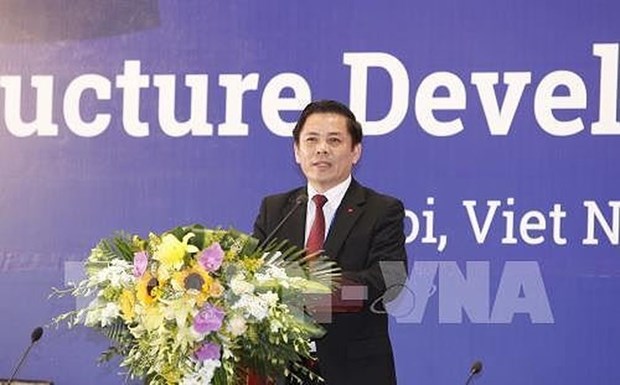 Vietnamese Minister of Transport Nguyen Van The addresses a session on infrastructure development and financing as part of the GMS Business Summit in Hanoi on March 30. (Photo: VNA)
Vietnamese Minister of Transport Nguyen Van The addresses a session on infrastructure development and financing as part of the GMS Business Summit in Hanoi on March 30. (Photo: VNA)
In recent years, the Vietnamese
Government has spent about 9-10 percent of its annual GDP on transport, energy,
telecommunications and water infrastructure, he said.
However, the transport infrastructure
system in Vietnam is still small in terms of scale with asynchronous connections.
The country has only 756 kilometres of expressway while the railway system is
out-of-date.
According to the minister, Vietnam
plans to step up development of high-quality transport infrastructure to spur its
socio-economic growth. It will continue
completing its expressway system. Between now and 2020, the country expects to
finish construction of about 654 kilometres out of 1,300 kilometres of the north-south
expressway in the form of public-private partnership (PPP).
It also considers the building of new
roads and high-speed railways to get connected with ASEAN, GMS and trans-Asia
road systems, while paying attention to airport development, including the
construction of Long Thanh International Airport with annual capacity of 100
million passengers and 5 million tonnes of cargo in the southern province of
Dong Nai, The said.
He revealed that Vietnam needs an
estimated 1,015 quadrillion VND (44.7 billion USD) in investment to develop
transport infrastructure in the 2018-2023 period.
Of the total, 651 trillion VND is for road development, 119 trillion VND for
railways, 101 trillion VND for air transport, 68 trillion VND for sea routes
and more than 33 trillion VND for inland waterways.
About 300 trillion VND (14 billion USD) is expected to come from non-budget
sources inside and outside the country, especially foreign investment.
Therefore, Vietnam calls on businesses, investors and development partners to
invest in developing transport infrastructure in Vietnam as well as other GMS
nations, thus turning the GMS into a prosperous and developed sub-region, The
stressed.
Enhancing transport connectivity for
prosperous GMS
Transport connectivity is a top
priority of the GMS Economic Cooperation Programme. At the time when the
programme was launched, most of the sub-region’s infrastructure was in very
poor quality. In response to this, the GMS adopted the Transport Master Plan in
1995, which identified priority transport links – mostly road projects –
designed to generate the greatest and most immediate connectivity improvements.
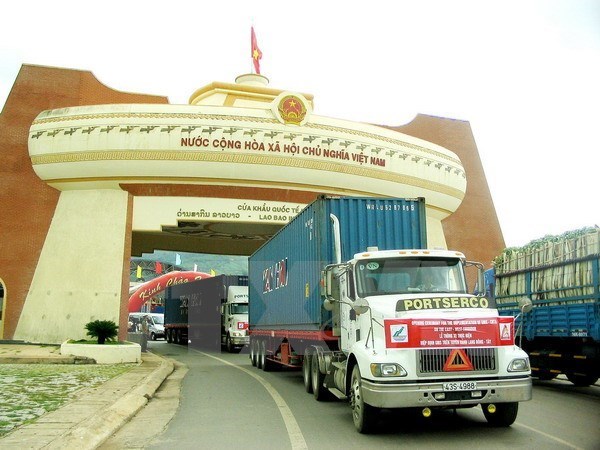 Trucks pass the Lao Bao International Border Gate in central Quang Tri province, which borders Laos (Photo: VNA)
Trucks pass the Lao Bao International Border Gate in central Quang Tri province, which borders Laos (Photo: VNA)
This was an important step in economic development, with improvements in
transportation infrastructure boosting economic opportunities throughout the region,
especially by reducing travel times and costs. As the countries have moved from
a strategy of self-sufficiency to regional cooperation, major efforts have been
made to develop infrastructure linking the GMS and beyond, particularly through
the identification of economic corridor projects.
A GMS transport strategy for 2006-2015 was developed to build a seamless GMS
transport network, connecting not only sub-regional nations but also
neighbouring countries and regions.
Now, the GMS transport strategy
towards 2030, with a vision of “seamless, efficient, reliable, and sustainable
GMS transport system”, recommends expanding road and railway connections,
focusing on multimodal transport development and integrating climate change
assessments into transport development projects.
The sub-region’s member nations have pledged to implement the GMS Cross-Border
Transport Facilitation Agreement (GMS-CBTA) to boost economic cooperation and
development.
Turning the countries’ infrastructure into economic corridors, generating jobs,
developing tourism and trade, creating cohesion in terms of interest and
promoting peace in the region are among the GMS’s goals.
“Infrastructure is the key of the GMS
connectivity, especially the inland connectivity. It is the trend of our sub-region
to enhance the inland connectivity,” Tak Sriratanobhas, a member of the Thai
Chamber of Commerce and Board of Trade told the Vietnam News Agency on the
sidelines of the GMS Business Summit, which took place in Hanoi on March 30 as
part of the sixth GMS Summit.
The key is turning infrastructure from transport corridors to economic corridors,
meaning hardware and software infrastructure must combine, he said, adding that
the hardware is the efficiency of roads linking the countries while the
software is how to go through the border easier, faster and cheaper.
“If we make the border crossing more efficient, faster and less costly, it is
the key to successfully turning the region into a real economic corridor,” he
noted.
According to Chris Malone, Partner and Managing Director at the Boston
Consulting Group, the GMS countries need to work together to have a win-win
solution so all of them benefit from further infrastructure connectivity and
contribute to economic development as well as the harmony of people in the
Mekong River.
Transport infrastructure development
will help optimise the supply chain of companies, reduce their costs and make
them more competitive, said Csaba Bundik, Vice Chairman of the Central and
Eastern European Chamber of Commerce in Vietnam.
“A better linked infrastructure will make people’s life and companies’
operation easier,” he noted.
The current trade among the GMS
countries could double if there is better infrastructure in the region,
according to Htun Zaw, Deputy Director General of the Foreign Economic
Relations Department under the Ministry of Planning and Finance of Myanmar.
“There is a huge opportunity to increase infrastructure connectivity in the
region but the real challenge is funds,” he said.
Meanwhile, Japanese Ambassador to Vietnam Umeda Kunio said at the session on
infrastructure development and financing of the GMS Business Summit in Hanoi on
March 30 that his government has put forth an initiative to promote quality
infrastructure and made efforts to improve connectivity in the GMS region.
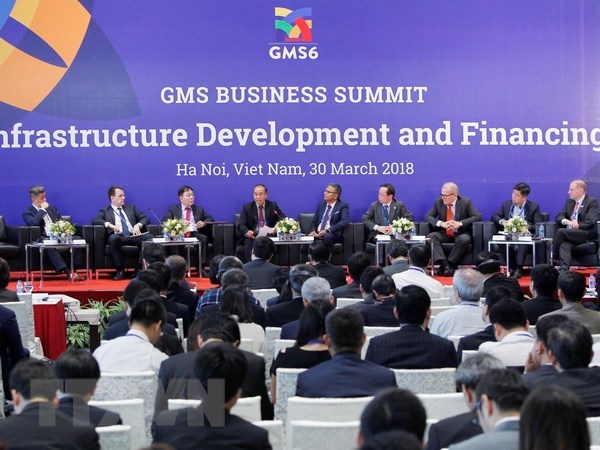 Delegates discuss GMS infrastructure development and financing (Photo: VNA)
Delegates discuss GMS infrastructure development and financing (Photo: VNA)
As a partner of the GMS, Japan has
provided support for fostering regional economic growth, contributing to
narrowing the development gap as well as boosting investment and trade through
infrastructure projects.
Japan’s assistance not only covers
hard infrastructure such as expressways and bridges but also human resources
training and development of areas along the economic corridor, he said.
The ADB has for years been a major sponsor of the GMS. ADB President Takehiko
Nakao said his bank plans to provide 7 billion USD over the next five years for
a range of projects supporting transportation, tourism, energy, climate change
mitigation and adaptation, agribusiness value chains and urban development in
the sub-region.
The sub-region is expected to receive
66 billion USD in investment to strengthen regional economic cooperation in the
next five years, Alfredo Perdiguero, Director of Regional Cooperation and
Operations Coordination Division, Southeast Asia Department, told Vietnamese
media.
The sum increased by 2 billion USD
compared to what ministers of the six member countries agreed in the action
plan framework for 2018-2022 late last year.
It will more than triple the total sum
of 21 billion USD mobilised for the region since the GMS economic cooperation
programme was first launched by the ADB in 1992.
Besides the ADB, the amount is also expected to be contributed by many other
partners, together with the governments of the GMS countries, he noted.
The GMS cooperation was launched in
1992 as an initiative of the ADB. The GMS Cooperation Programme is the most
complete cooperation programme that involves Vietnam, Laos, Cambodia, Thailand,
Myanmar, and China’s Yunnan and Guangxi provinces. The programme prioritises
infrastructure development, energy, telecommunication, tourism,
trade-investment, human resources, and environment.-VNA





